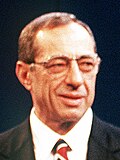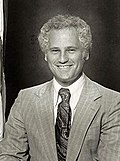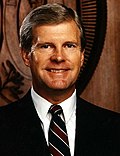Top Qs
Timeline
Chat
Perspective
1986 United States gubernatorial elections
From Wikipedia, the free encyclopedia
Remove ads
United States gubernatorial elections were held on November 4, 1986, in 36 states and two territories. The Democrats had a net loss of eight seats during this election, which coincided with the Senate and the House elections. This was despite the Democratic trend on a federal level, making this the last midterm election until 2022 where the party of the incumbent president achieved a net gain of governorships.
This article needs additional citations for verification. (March 2025) |
Remove ads
Election results
States
Territories and federal district
Remove ads
Close states
States where the margin of victory was under 1%:
- Idaho, 1.0%
States where the margin of victory was under 5%:
- Pennsylvania, 2.3%
- Oklahoma, 2.9%
- South Carolina, 3.1%
- South Dakota, 3.6%
- Iowa, 3.9%
- Hawaii, 4.0%
- Oregon, 4.0%
- Alaska, 4.7%
States where the margin of victory was under 10%:
- Arizona, 5.2%
- Nebraska, 5.8%
- New Mexico, 6.0%
- Wisconsin, 6.5%
- Texas, 6.7%
- New Hampshire, 7.4%
- Guam, 7.6%
- Wyoming, 8.0%
- Tennessee, 8.6%
- Vermont, 8.7%
- Florida, 9.2%
- Maine, 9.7%
Remove ads
Alabama
The 1986 Alabama gubernatorial election saw the election of Republican H. Guy Hunt over Democrat Bill Baxley. In state politics, this election is largely seen as a realigning election since Hunt was the first Republican to be elected governor in 114 years – the last Republican to be elected was David P. Lewis in 1872 during the Reconstruction era. In March 1986, incumbent George Wallace announced that he would not seek a fifth term as governor, ending an era in Alabama politics.
Alaska
Summarize
Perspective
The 1986 Alaska gubernatorial election took place on November 4, 1986, for the post of Governor of Alaska. Incumbent Governor Bill Sheffield, a Democrat who was seeking re-election, was defeated by Steve Cowper in the Democratic primary election on August 26, 1986.[4][5]
In the general election, Democratic state Representative Steve Cowper defeated Republican candidate Arliss Sturgulewski and Alaska Independence candidate Joe Vogler. Sturgulewski had defeated former governor Wally Hickel, former Libertarian nominee Dick Randolph, former State House Speaker Joe L. Hayes, and former Alaskan Independence nominee Don Wright for the Republican nomination.
Remove ads
Arizona
The 1986 Arizona gubernatorial election took place on November 4, 1986, for the post of Governor of Arizona. Republican Evan Mecham, who defeated Burton Barr for the Republican nomination, defeated the Democratic nominee and State Superintendent Carolyn Warner and independent candidate Bill Schulz.
Remove ads
Arkansas
Summarize
Perspective
The 1986 Arkansas gubernatorial election was conducted on November 4, 1986, to elect the Governor of Arkansas. Incumbent Democratic Governor Bill Clinton stood for re-election. He had been elected in 1982 and re-elected in 1984, and sought a third consecutive term and fourth overall (Clinton had been first elected in 1978). His opponent was former Republican Governor Frank D. White, who was seeking to return to the office he had defeated Clinton for in the 1980 election.
Clinton had defeated former Governor Orval Faubus for the Democratic nomination, while White defeated former Lieutenant Governor Maurice Britt in the Republican primary.
Remove ads
California
The 1986 California gubernatorial election took place on November 4, 1986. Incumbent Republican George Deukmejian won easily in this rematch over the Democratic challenger, Los Angeles Mayor Tom Bradley. This was the largest gubernatorial victory since that of Earl Warren in 1946, who won 91.64% of the vote.
Remove ads
Colorado
The 1986 Colorado gubernatorial election was held on November 4, 1986. Democratic nominee Roy Romer defeated Republican nominee Ted L. Strickland with 58.20% of the vote.
Remove ads
Connecticut
Summarize
Perspective
The 1986 Connecticut gubernatorial election took place on November 4, 1986. Incumbent Democratic governor Bill O'Neill won his second full term against Republican assemblywoman Julie Belaga, who defeated Jerry Labriola for the Republican nomination. This election marked the last time a Democrat would win the governorship in Connecticut until the 2010 election, the last time a Democratic gubernatorial candidate has won every county in the state and the last time a Democrat won by a margin of larger than 5 percent until the 2022 election.
Florida
The 1986 Florida gubernatorial election took place alongside the midterm congressional elections. The Democratic Party won many victories across the country (including retaking the Senate). However, in Florida, where Democrats gained the Senate seat from Republicans, they lost the Governorship for just the second time since Reconstruction.
Remove ads
Georgia
The 1986 Georgia gubernatorial election was held on November 4, 1986. Governor Joe Frank Harris (D) was overwhelmingly re-elected over Guy Davis (R) to win re-election.
Remove ads
Hawaii
The 1986 Hawaii gubernatorial election was Hawaii's eighth gubernatorial election. The election was held on November 4, 1986, and resulted in a victory for the Democratic candidate, Lt. Gov. John D. Waiheʻe III over the Republican candidate, State Senator D. G. Anderson.[6]
Idaho
The 1986 Idaho gubernatorial election was held on November 4, 1986 to elect the governor of the state of Idaho. Cecil Andrus, a former Democratic governor, was elected defeating the Republican Lieutenant Governor David Leroy.
This was an open seat election; longtime incumbent John V. Evans ran for the U.S. Senate, but lost. This was the first open-seat gubernatorial election in Idaho or the first open-seat Idaho gubernatorial election since 1954.
Illinois
Summarize
Perspective
The 1986 Illinois gubernatorial election was held on November 4, 1986. Republican candidate James R. Thompson won a fourth term in office, defeating the Illinois Solidarity Party nominee, former United States Senator Adlai Stevenson III, by around 400,000 votes.
Iowa
The 1986 Iowa gubernatorial election was held on November 4, 1986. Incumbent Republican Terry Branstad defeated Democratic nominee Lowell Junkins with 51.91% of the vote.
Kansas
The 1986 Kansas gubernatorial election was held on November 4, 1986. Incumbent Democratic Governor John W. Carlin did not run for re-election. Republican nominee Mike Hayden, then Speaker of the Kansas House of Representatives, beat the Democratic nominee Thomas Docking, who was then the incumbent Lieutenant Governor of Kansas.[7] This was the last gubernatorial election in Kansas in which the winner was of the same party as the incumbent president until Laura Kelly's victory in 2022.
Maine
The 1986 Maine gubernatorial election took place on November 4, 1986. Incumbent Democratic Governor Joseph Brennan was term limited and ineligible to seek re-election. First district Congressman John McKernan defeated Democratic Party challenger James Tierney as well as former Republican turned Independent Sherry Huber and former Portland, Maine, city manager John Menario, making McKernan the first Republican to win The Blaine House since 1962.
Maryland
The 1986 Maryland gubernatorial election was held on November 4, 1986. Democratic nominee William Donald Schaefer defeated Republican nominee Thomas J. Mooney with 82.37% of the vote.
Massachusetts
The 1986 Massachusetts gubernatorial election was held on November 4, 1986. Michael Dukakis was elected Governor of Massachusetts for a third term. He defeated Republican George Kariotis by a 69–31% margin. This was the last time a Democrat was elected governor of Massachusetts until 2006.
Michigan
Summarize
Perspective
The 1986 Michigan gubernatorial election was held on November 4.
The primary elections occurred on August 6, 1986.[9] The Democrats nominated incumbent governor James Blanchard. The Republicans nominated Wayne County executive William Lucas, who made history by being the first African-American nominee by either major party for Governor of Michigan.
Blanchard was re-elected by a landslide, winning the election with 68.1% of the vote.[10]
Minnesota
The 1986 Minnesota gubernatorial election took place on November 4, 1986. Minnesota Democratic–Farmer–Labor Party candidate Rudy Perpich defeated Independent-Republican Party challenger Cal Ludeman. George Latimer unsuccessfully ran for the Democratic nomination.
Democrats would not win another gubernatorial election in the state until 2010.
Nebraska
The 1986 Nebraska gubernatorial election was held on November 4, 1986, and featured state Treasurer Kay Orr, a Republican, defeating Democratic nominee, former Mayor of Lincoln Helen Boosalis. Incumbent Democratic governor Bob Kerrey did not seek a second term.
The election was the first state gubernatorial election in U.S. history where the candidates of both major national parties were women.[11]
Nevada
The 1986 Nevada gubernatorial election took place on November 4, 1986. Incumbent Democrat Richard Bryan won re-election to a second term as Governor of Nevada, defeating Republican nominee Patty Cafferata.
New Hampshire
The 1986 New Hampshire gubernatorial election took place on November 4, 1986. Incumbent Governor John Sununu was re-elected to a third term in office, defeating Paul McEachern, who had defeated Paul M. Gagnon for the Democratic nomination.
New Mexico
The 1986 New Mexico gubernatorial election took place on November 4, 1986, in order to elect the governor of New Mexico. Due to term limits, incumbent Democratic governor Toney Anaya was ineligible to seek a second term as governor.
New York
The 1986 New York gubernatorial election was held on November 4, 1986, to elect the Governor and Lieutenant Governor of New York. Incumbent Democratic governor Mario Cuomo defeated Republican Andrew O'Rourke, the County Executive of Westchester County in a landslide. Cuomo carried all but 5 counties.
Ohio
The 1986 Ohio gubernatorial election was held on November 4, 1986. Incumbent Democratic Governor Dick Celeste ran against four time former Governor Jim Rhodes, who had previously defeated the last two incumbent Democratic governors in 1962 and 1974.
Oklahoma
The 1986 Oklahoma gubernatorial election was held on November 4, 1986, to elect the governor of Oklahoma. Republican former Governor and Senator Henry Bellmon won the election by a plurality with Independent Jerry Brown receiving more than twice the number of votes separating Bellmon from Democrat David Walters.[12]
Oregon
The 1986 Oregon gubernatorial election took place on November 4, 1986. Democratic nominee Neil Goldschmidt defeated Republican Norma Paulus to win the election.
Pennsylvania
The 1986 Pennsylvania gubernatorial election was held on November 4, 1986. Democrat Bob Casey narrowly defeated Republican Bill Scranton III, in a race that featured two very high-profile candidates.
Rhode Island
The 1986 Rhode Island gubernatorial election was held on November 4, 1986. Incumbent Republican Edward D. DiPrete defeated Democratic nominee Bruce Sundlun with 64.70% of the vote.
South Carolina
The 1986 South Carolina gubernatorial election was held on November 4, 1986, to select the governor of the state of South Carolina. Carroll A. Campbell Jr., a Republican representative of the 4th congressional district, narrowly defeated Democrat Michael R. Daniel to become the 112th governor of South Carolina and only the second Republican governor since Reconstruction.
South Dakota
The 1986 South Dakota gubernatorial election was held on November 4, 1986 to elect the Governor of South Dakota. Incumbent Bill Janklow was term-limited, so the field for the new governor was open. Republican nominee George S. Mickelson was elected, defeating Democratic nominee Ralph Lars Herseth.
Tennessee
The 1986 Tennessee gubernatorial election was held on November 4, 1986, to elect the next governor of Tennessee. Democratic nominee Ned McWherter defeated former Republican governor Winfield Dunn with 54.3% of the vote.
Texas
The 1986 Texas gubernatorial election was held on November 4, 1986, to elect the governor of Texas. The election was a rematch of the 1982 election, as incumbent Democratic governor Mark White ran for reelection against former Republican governor Bill Clements. Clements was elected to a second, non-consecutive term as governor, winning 53% of the vote to White's 46%.
Vermont
Summarize
Perspective
The 1986 Vermont gubernatorial election took place on November 4, 1986. Incumbent Democrat Madeleine Kunin ran successfully for re-election to a second term as Governor of Vermont, defeating Republican candidate Peter Plympton Smith and independent candidate Bernie Sanders. Since no candidate won a majority of the popular vote, Kunin was elected by the Vermont General Assembly per the state constitution.
Wisconsin
The 1986 Wisconsin gubernatorial election was held on November 4, 1986. Republican Tommy G. Thompson won the election with 53% of the vote, winning his first term as Governor of Wisconsin and defeating incumbent Governor Anthony S. Earl.[13] This was the first time since 1962 that the winner of a Wisconsin gubernatorial election was of the same party as the incumbent president. Jonathan B. Barry unsuccessfully sought the Republican nomination.
Wyoming
The 1986 Wyoming gubernatorial election took place on November 4, 1986. Popular three-term Democratic Governor Edgar Herschler announced that he would not seek a fourth term, creating an open seat.[14] Attorney Mike Sullivan emerged as the unlikely Democratic nominee, and faced former state representative Pete Simpson, the Republican nominee and the brother of then-U.S. senator Alan K. Simpson, in the general election. Despite Sullivan's political inexperience, he was able to defeat Simpson by a decisive margin, winning his first of two terms in office.
Territories and federal district
Summarize
Perspective
District of Columbia
On November 6, 1986, Washington, D.C., held an election for its mayor, with Democratic candidate and incumbent mayor Marion Barry defeating Republican candidate Carol Schwartz.
Guam
U.S. Virgin Islands
See also
Notes
- Babbitt took office after his predecessor (Wesley Bolin) died.
- O'Neill took office after his predecessor (Ella Grasso) resigned. He was subsequently elected in the 1982 Connecticut gubernatorial election.
- Evans took office after his predecessor (Cecil Andrus) resigned.
- Stevenson was originally the Democratic gubernatorial nominee but later withdrew when several Lyndon LaRouche supporters won spots on the Democratic ticket. See Solidarity Party for more details
- Perpich took office after his predecessor (Wendell R. Anderson) resigned.
- Kunin did not win a majority of the votes; therefore, the state assembly had to cast the final vote.
References
Wikiwand - on
Seamless Wikipedia browsing. On steroids.
Remove ads















































































































